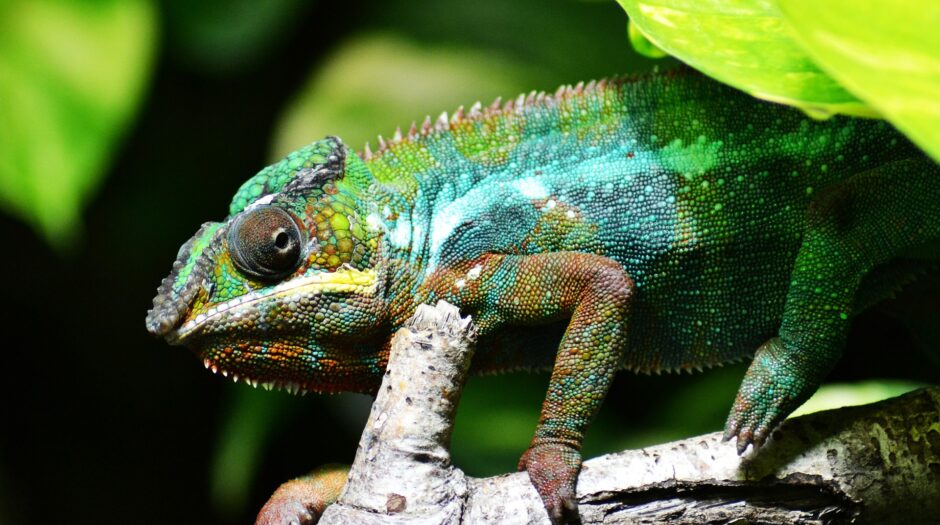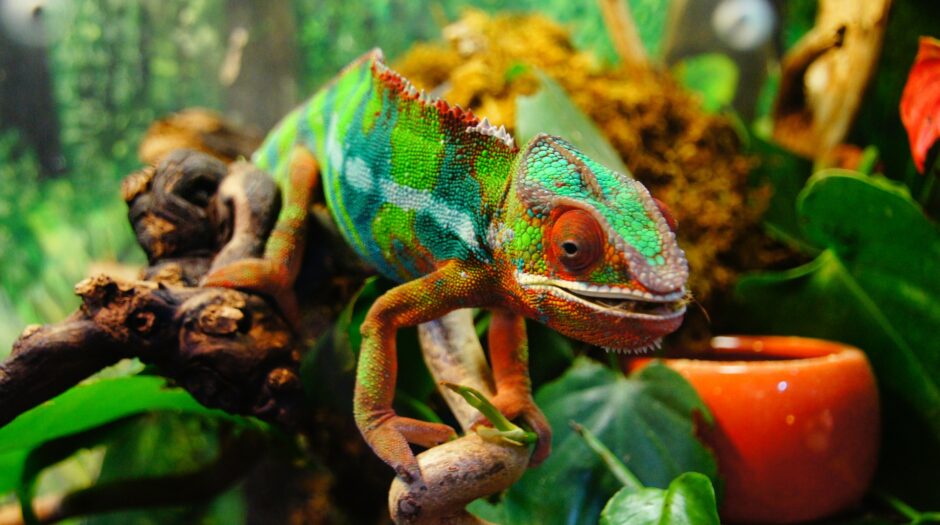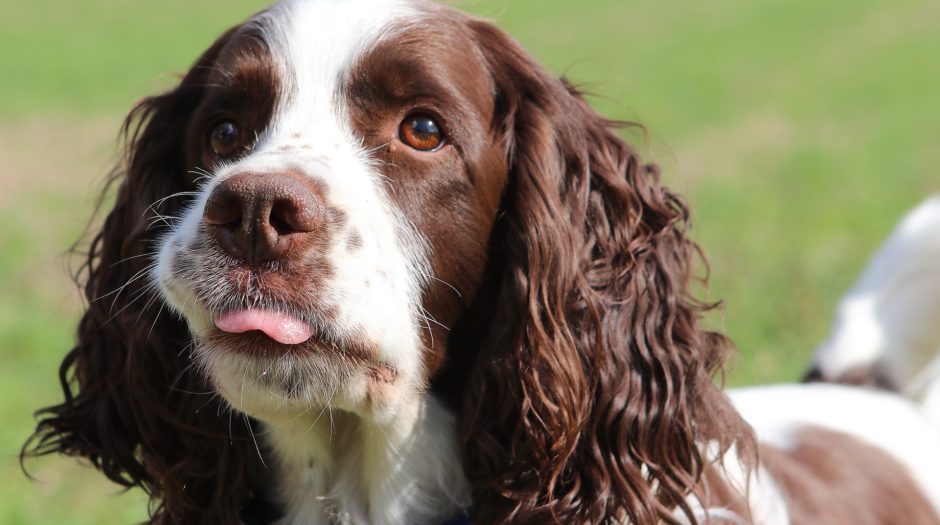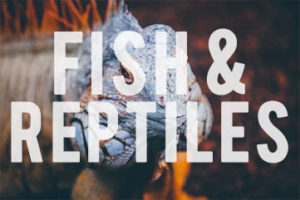How To Set Up a Crested Gecko Enclosure | Beginners Guide
Crested geckos require a suitable enclosure setup to live a happy and healthy life, which is why it is important to know their requirements and how to properly set up a vivarium.
This article will go over the appropriate tank size, drainage, substrate, accessories, and more!
We may earn a commission if you decide to purchase something on this page (Thanks!).

Tank Size and Structure
The first thing you need to do is find the right kind of vivarium for your crested gecko. Like other pets, sizing is an important factor to consider. With crested geckos, height is more important that width due to them being natural climbers. Dimension wise, a 18″ x 18″ x 24″ tank works best, however, a 12″ x 12″ x 18″ enclosure is sufficient. That being said, it’s recommended to go with the larger one because your crested gecko will be much happier and it opens up the option of adding in a 2nd gecko later on.
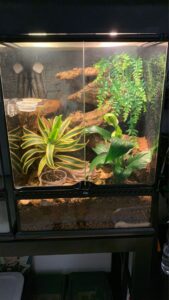
Image Credit= Exo Terra & Offer Up
If you don’t mind spending the extra money, we highly recommend you get the Exo Terra Terrarium (18 x 18 x 24).
- Glass terrarium for reptiles or amphibians
- Patented front window ventilation
- Raised bottom frame in order to fit a substrate heater and has a waterproof bottom
This vivarium will be better in the long run as it saves a lot of time and effort. Exo Terra also has a great reputation among reptile owners and is a favourite for many. Plus, it has many advantages such as front facing glass doors (as opposed to reaching through the top of the tank), the perfect size, a waterproof bottom, and it being pretty much escape-proof.

Drainage
A good setup will include some sort of drainage layer at the bottom to keep the substrate (usually soil) from getting waterlogged. This drainage system should also include a separation screen to keep the soil from mixing into the drainage layer. Typically, you only need a small layer of hydroballs (leca, hydroton), lavarock or pea gravel. Hydroton is a much lighter alternative to gravel.
*be careful you don’t fill it too full or the soil will overflow out the doors when you water. You only need a small layer of hydroballs (or lavarock/peagravel).

Substrate
The type of substrate you should use is highly dependent on your crested geckos age and size. This is because younger Crested Geckos are at a higher risk of impaction, which us an intestinal block often caused by eating substrate. Impaction can often be fatal and is a very serious issue that you should be aware about. Adult Crested geckos usually avoid substrate while eating.
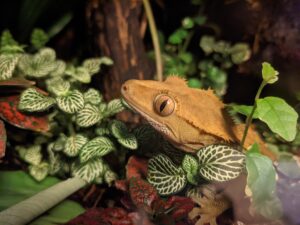
For geckos under 15 grams (~6-8 months), we recommend lining the bottom with paper towels. While this isn’t the most attractive substrate, it does have it’s benefits. For one, there is no risk of impaction. They hold in moisture, are much cheaper than actual substrate and are super easy to clean.
When geckos pass 15 grams, many gecko owners prefer to switch to a natural substrate. They are at a much lower risk of impaction when they mature because their digestive system is stronger than before. That being said there will always be a small risk of impaction when dealing with loose substrate, the chances are just lower.
If you do choose to switch, we recommend the Zoo Med Eco Earth Bricks. This is one of the most widely-used crested gecko substrates among owners and is 100% natural/eco-friendly. Alternatively, you could check out this article (click here).

ACCESSORIES:
It is very important to fill your crested geckos vivarium with a variety of suitable plants, logs, and other things. This not only adds to the overall look of the enclosure but is also extremely important for your geckos long-term happiness, comfort, and even health.
Crested geckos tend to love having a lot of decor in their cage so don’t worry too much about whether or not you are adding too much. More decor means they have more places to hide and climb, which they love. Plus, this means you can customize it to fit your home & overall look you might be going for. Be creative!
Plants and Vines
Plants and vines are important to add to your geckos habitat, especially since crested geckos spend the majority of their time in trees and other plants. When it comes to plants there are generally two main options; artificial plants and live plants. If you’d like to go the easier route, it’s recommended to go 100% artificial because live plants require extra work.
If you decide to go down the live plant route, make sure to rehydrate the soil/substrate (not too much) so that it is suitable for the plants to live in. Also, make sure you are using plants that are suitable for your gecko and their environment. (google something like “safe plants for crested geckos” and you’ll find tons of resources)
Vines aren’t necessarily a requirement, however, many crested geckos like them and they are great to drape across the terrarium. There are a few options regarding the look and whether or not you want suction cups.
Image Credit: Pinterest
Logs/Branches
Crested Geckos are known to be tree dwellers, meaning they tend to spend a lot of their time above the ground (Plus, they love climbing). This is why it is important to add in lots of logs and branches to your setup. If you would like to buy branches, here are a few of our recommendations…
If you prefer to go the cheaper route, you may decide to collect your own wood from outside. Keep in mind though, it requires more work. Collecting wood from outside is completely safe as long as you do it correctly. First, you will need to know what woods are considered safe for crested geckos. A few options include; Grape, Mopani, Oak, Birch, and more! (just google safe woods for crested geckos).
IMPORTANT: Keep in mind that wood from outside will most likely contain microorganisms and other things that can be harmful to your pet. If you decide to collect your own wood it is important to treat it correctly. First, scrub the wood with a 5% diluted bleach mixture. When you are done scrubbing, preheat your oven to 300°F and bake the wood for about 30 mins. (Keep an eye on it because it can be a fire hazard!) This should sterilise it the wood and make it completely safe for your crested geckos enclosure.
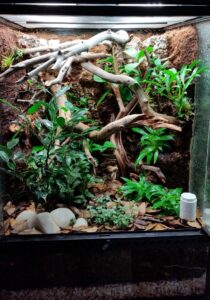
Image Credit: Dendroboard
Repti-Ledge
A proper crested gecko setup requires a repti-ledge, which is basically an elevated ledge for feeding. Crested geckos prefer to eat in more elevated space and are generally just more comfortable with the height. In fact, some crested geckos will refuse to eat food that is placed on the ground. You can find several versions online but here are a few of our recommendations…
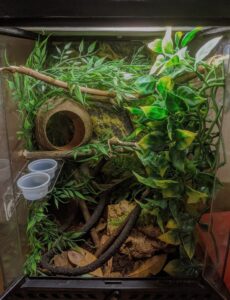
Image Credit: The Pet Enthusiast

OTHER THINGS TO CONSIDER:
Crested geckos don’t require a complicated setup like some other reptiles when it comes to things like lighting and heating requirements. Crested geckos are primarily nocturnal animals, meaning they don’t really require any UVB lighting. If you want a viewing light, an eco-terra LED is a great option, however, it is not required.
Temperature
Crested geckos require a temperature of between 21-23 °C (70-75°F). As long as your geckos enclosure stays between that range, your gecko will be comfortable, happy, and healthy. Depending on where you live and your personal preferences temperature wise, this range shouldn’t be a problem and no heating devices are necessary.
During the winter (or night), if your house temperature drops below 15°C (60°F), consider investing a Ceramic Heat Emitter. If you are using a heater, make sure the temperature stays between that range and does not exceed 29°C (85°F) because crested geckos don’t do well in those temperatures. If your home temperature rises to those temperatures, it’s time to start taking measures to cool down your gecko.
Humidity
It is important to control the humidity in your cresties vivarium, in fact it’s a vital part of caring for your gecko. In the wild, crested geckos mostly inhabited rainforests. Naturally, this means that crested geckos prefer relatively high humidity levels.
In order to accurately measure the humidity in your gecko enclosure, a hygrometer is recommended. Try to stay away from the dial analong ones because they tend to be inaccurate.
*Make sure to research how to increase and balance the humidity to be comfortable for your gecko!
We reccommend getting one that indicates both humidity levels and the temperature in the enclosure (as shown below), however, if you prefer to just get a hydrometer by itself there is also that option (also shown below)…

We hope this guide helped you set up your crested gecko enclosure! Consider posting a picture on instagram and tag us @crittermamas so we can see your beautiful setups.
While you’re still here, check out our article called DIYs and Life Hacks for Reptile Owners for some fun, creative ideas and projects.

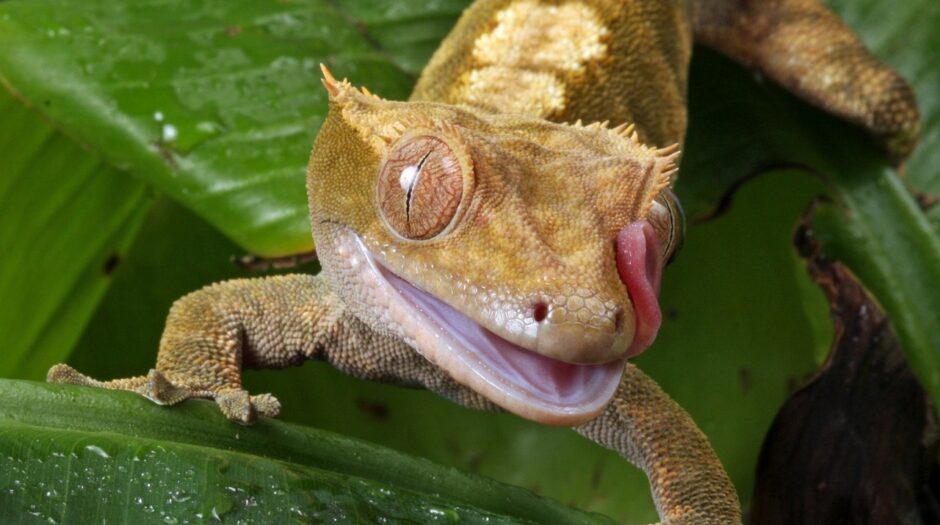









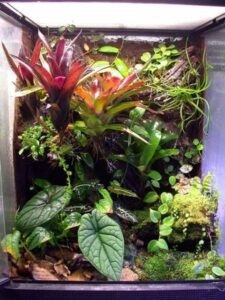

![Cork Bark Round for Terrarium [Set of 2] Size: Small (2' H x 10' W x 10' L)](https://m.media-amazon.com/images/I/51HktWV3lVL.jpg)









